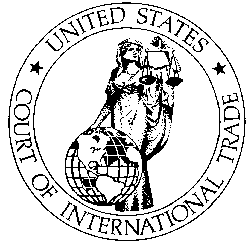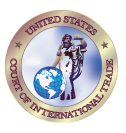Foreword
History of International Trade Litigation
Compostion of the Court
Jurisdiction of the Court
Practice and Procedures Before the Court
Further Information
This discussion is designed to provide you with an introduction to the United States Court of International Trade and its special role in the federal judicial system. The Court serves an important judicial function, contributing to the rule of law through its significant responsibilities in the area of international trade.
From the time of its establishment, the United States Court of International Trade and its predecessor bodies have been designed to provide “a comprehensive system for judicial review of civil actions arising out of import transactions and federal transactions affecting international trade.” This system, now established under Article III of the U.S. Constitution, is rooted in the mandate of Article I, Section 8 of the U.S. Constitution, providing that “all Duties, Imposts and Excises shall be uniform throughout the United States.” The Court, thus, ensures expeditious procedures, avoids jurisdictional conflicts among federal courts, and provides national uniformity in the judicial decision-making affecting import transactions.
As the impact of international trade on the U.S. economy has expanded, there has been a corresponding increase in international trade disputes — involving governments, foreign and domestic manufacturers, workers’ unions, trade associations, and individuals — and a continued need to provide consistent, fair, and impartial adjudication of these disputes. While the nature of these disputes shifts between classification and valuation, unfair trade practices, and various types of enforcement measures, the United States Court of International Trade continues to strive for the “just, speedy, and inexpensive determination of every action and proceeding” brought before it.
We are pleased to provide you with this brief description of the United States Court of International Trade and hope that you find it useful.
Mark A. Barnett
Chief Judge
HISTORY OF INTERNATIONAL TRADE LITIGATION
The Customs Courts Act of 1980, historically the most significant legislation affecting international trade litigation, is also the most recent attempt by Congress to design the best judicial system for corrective justice in this area. The role of the United States Court of International Trade--as a constituent and significant part of the federal judicial system--is the culmination of a continuous process of empiric legislation enacted over the past 200 years.
The first case tried before the first judge appointed to the first court organized under the Constitution of the United States involved a dispute arising from an importation into the new nation. Since that time, Congress periodically has addressed the many complex issues involved in resolving international trade disputes to solve specific problems or meet specific needs at particular times.
In 1890, Congress provided for a Board of General Appraisers, a quasi-judicial administrative unit within the Treasury Department. The nine general appraisers reviewed decisions by United States Customs officials concerning the amount of duties to be paid on importations.
As the number and types of decisions relating to importations expanded, Congress, in 1926, replaced the outmoded Board of General Appraisers with the United States Customs Court, a court established under Article I of the Constitution. However, the change was little more than a change in name, for the jurisdiction and powers of the tribunal remained essentially the same, and the Customs Court continued to function as did the Board of General Appraisers.
Over the next thirty years, the Customs Court gradually was integrated into the federal judicial system until, in 1956, Congress declared the court to be a court established under Article III of the Constitution. Despite this important change in status, the jurisdiction, powers, and procedures of the court followed the pattern of its statutory predecessors.
In the late 1960's, Congress recognized that fundamental changes were needed in the court's statutory procedures as well as in its jurisdiction and powers. The scope of these changes was so broad that Congress, in the Customs Courts Act of 1970, limited its efforts to procedural reforms. Congress deferred for subsequent legislation the remaining substantive issues concerning the court's jurisdiction and remedial powers, which were addressed in the Customs Courts Act of 1980.
As described by Senator Dennis DeConcini, Chairman, Subcommittee on Improvements in Judicial Machinery, Committee on the Judiciary, United States Senate, and a sponsor of the Customs Courts Act of 1980:
"This legislation will offer the international trade community, as well as domestic interests, consumer groups, labor organizations, and other concerned citizens, a vastly improved forum for judicial review of administrative actions of government agencies dealing with importations. The provisions make it clear to those who suffer injury in this area that they may seek redress in a court, and if they are successful, the Court of International Trade will be able to afford them relief which is appropriate and necessary to make them whole."
The President, with the advice and consent of the Senate, appoints the nine judges who constitute the United States Court of International Trade, which is a national court established under Article III of the Constitution.
The judges, who are appointed for life, as are all judges of Article III courts, may be designated and assigned temporarily by the Chief Justice of the United States to perform judicial duties in a United States Court of Appeals or a United States District Court.
The chief judge of the Court of International Trade is a statutory member of the Judicial Conference of the United States, and convenes a judicial conference of the Court of International Trade periodically for the purposes of considering the business and improving the administration of justice in the court.
The Judicial Conference of the United States serves as the principal policy making body concerned with the administration of the United States Courts.
The chambers of the judges, the courtrooms, and the offices of court are located at One Federal Plaza in New York City at the Courthouse of the United States Court of International Trade.
The geographical jurisdiction of the United States Court of International Trade extends throughout the United States. The court can and does hear and decide cases which arise anywhere in the nation. The court also is authorized to hold hearings in foreign countries.
The different types of cases the court is authorized to decide--that is, its subject matter jurisdiction--are limited and defined by the Constitution and specific laws enacted by the Congress.
The subject matter jurisdiction of the court was greatly expanded by the Customs Courts Act of 1980. Under this law, in addition to certain specified types of subject matter jurisdiction, the court has a residual grant of exclusive jurisdictional authority to decide any civil action against the United States, its officers, or its agencies arising out of any law pertaining to international trade.
This broad grant of subject matter jurisdiction is complemented by another provision in the Customs Courts Act of 1980 which makes it clear that the United States Court of International Trade has the complete powers in law and equity of, or as conferred by statute upon, other Article III courts of the United States. Under this provision, the court may grant any relief appropriate to the particular case before it, including, but not limited to, money judgments, writs of mandamus, and preliminary or permanent injunctions.
The Congressional intent for these broad grants of authority was explained by the Honorable Peter W. Rodino, Jr., then Chairman, Committee on the Judiciary, House of Representatives, and a sponsor of the Customs Courts Act of 1980:
"The essential purpose of this legislation is best summarized by the following quote from the committee report:
"(P)ersons adversely affected or aggrieved by agency actions arising out of import transactions are entitled to the same access to judicial review and judicial remedies as Congress had made available for persons aggrieved by actions of other agencies."
In addition to these lawsuits against the United States, the court also has exclusive subject matter jurisdiction of certain civil actions brought by the United States under the laws governing import transactions, as well as counterclaims, cross-claims, and third-party actions relating to actions pending in the court.
PRACTICE AND PROCEDURES BEFORE THE COURT
The judicial power of the United States Court of International Trade in any particular case is exercised by a single judge to whom the case is assigned by the chief judge. When a case involves the constitutionality of an act of Congress, a Presidential proclamation, or an Executive order, or otherwise has broad and significant implications, the chief judge may assign the case to a three-judge panel.
Appeals from final decisions of the court may be taken to the United States Court of Appeals for the Federal Circuit and, ultimately, to the Supreme Court of the United States.
The court has its own rules prescribing the practices and procedures before the court. These rules are patterned after and follow the arrangement and numbering used in the Federal Rules of Civil Procedure. Similarly, with certain limited exceptions, the Federal Rules of Evidence govern the trial of cases before the court.
Since the geographical jurisdiction of the court extends throughout the United States, the procedures are designed to accommodate the needs of parties not located in New York City.
Most significantly, judges of the court are assigned by the chief judge, as needed, to preside at trials at any place within the United States. These trials are held in the United States Courthouses.
When a judge of the court conducts a trial outside New York City, the clerk of the district court in that judicial district may act as clerk of the United States Court of International Trade in matters relating to that case. And, when the judge conducts a jury trial, the clerk of the district court for the judicial district in which the trial is held acts as clerk of the Court of International Trade for purposes of selecting and summoning the jury.
The principal statutory provisions pertaining to the United States Court of International Trade are contained in the following sections of Title 28 of the United States Code: Organization, sections 251 to 258; Jurisdiction, sections 1581 to 1585; and Procedures, sections 2631 to 2647.

The seal of the court symbolizes that international trade disputes from around the world may be peaceably resolved consistent with the American traditions of judicial review of government actions and impartial justice in the United States Court of International Trade.
"THE STABILITY AND SUCCESS OF THE NATIONAL GOVERNMENT ... DEPEND IN CONSIDERABLE DEGREE ON THE INTERPRETATION AND EXECUTION OF ITS LAWS."
George Washington
To the Supreme Court
George Washington's message is carved in the marble wall on the west side of the entrance to the Ceremonial Courtroom in the United States Court of International Trade Courthouse.
"IT IS AS MUCH THE DUTY OF GOVERNMENT TO RENDER PROMPT JUSTICE AGAINST ITSELF IN FAVOR OF CITIZENS AS IT IS TO ADMINISTER THE SAME BETWEEN PRIVATE INDIVIDUALS."
Abraham Lincoln
First Message to Congress
Abraham Lincoln's message is carved in the marble wall on the east side of the entrance to the Ceremonial Courtroom.
